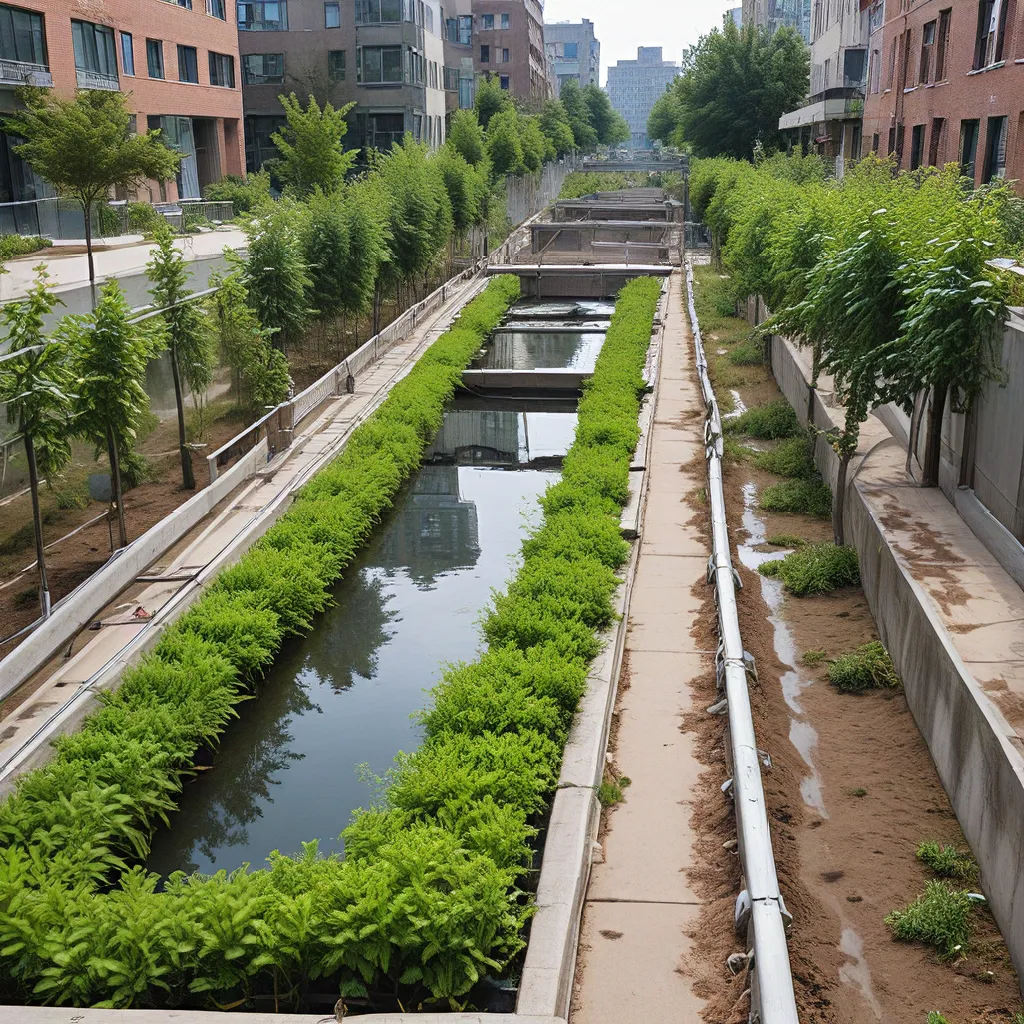
As a sustainability enthusiast, I’ve always been fascinated by the intersection of urban planning and environmental stewardship. That’s why I was thrilled when I stumbled upon the concept of integrating wastewater treatment with urban greening initiatives. It’s a brilliant idea that has the potential to transform the way we manage our cities and protect our natural resources.
Let me take you on a journey through this captivating intersection, where water and greenery come together to create a more resilient and sustainable future.
Unlocking the Potential of Green Infrastructure
At the heart of this concept is the idea of green infrastructure – a range of measures that utilize natural systems to manage stormwater and reduce the burden on traditional “gray” infrastructure like pipes and sewers. Green infrastructure can take many forms, from rain gardens and permeable pavement to urban wetlands and rooftop farms.
One of the key benefits of green infrastructure is its ability to filter and absorb stormwater where it falls, reducing the amount of pollutants and debris that end up in our local waterways. This not only helps to improve water quality, but it also mitigates the risk of flooding and infrastructure damage during heavy rainstorms.
But the benefits of green infrastructure don’t stop there. These natural systems can also provide a host of environmental, social, and economic advantages for the communities that embrace them. By incorporating more greenery into the urban landscape, we can enhance urban cooling, improve air quality, and create inviting public spaces that foster a sense of community.
Integrating Wastewater Treatment with Urban Greening
Now, let’s dive into the exciting intersection of wastewater treatment and urban greening. Imagine a world where the water that flows through our cities isn’t just a source of pollution, but a valuable resource that can be harnessed to support the growth of lush, vibrant greenery.
That’s exactly what some pioneering cities are doing. Take, for example, the Sincheon Sewage Treatment Facility in Daegu, South Korea. This facility not only treats 680,000 cubic meters of wastewater daily, but it also integrates renewable energy generation through solar panels and biogas production. By repurposing the water and energy generated from the wastewater treatment process, the facility is able to enhance the surrounding urban waterfront spaces and reduce its environmental impact.
Another inspiring example comes from Melbourne, Australia, where the Western Treatment Plant not only processes sewage but also supports a significant migratory bird habitat. By marrying water management and biodiversity conservation, this facility demonstrates the incredible synergies that can be achieved when we think holistically about the way we design and operate our urban infrastructure.
Empowering Communities Through Collaborative Efforts
One of the most exciting aspects of this integrated approach is the way it empowers local communities to take an active role in shaping the future of their cities. In Daegu, for instance, the city has launched the Solar Citizens project, which encourages residents to invest in rooftop solar installations and become part of the renewable energy revolution.
Similarly, Melbourne’s Power Melbourne initiative aims to establish a network of mid-scale batteries throughout the city, enhancing access to renewable energy and supporting the reliability and security of the electrical grid. By involving citizens in these initiatives, these cities are not only tackling environmental challenges but also fostering a sense of civic engagement and community ownership.
The Evolving Landscape of Wastewater Management
As we delve deeper into the world of integrated wastewater treatment and urban greening, it’s important to note that this is an ever-evolving landscape. New technologies, research, and policy developments are continuously shaping the way we approach these challenges.
For example, recent advancements in water reclamation and reuse technologies have opened up new possibilities for repurposing wastewater as a valuable resource. By treating and recycling wastewater, we can reduce the strain on freshwater supplies and use it to nourish our urban greenery, creating a truly closed-loop system.
Similarly, the Water Infrastructure Improvement Act of 2019 in the United States has further solidified the role of green infrastructure in stormwater management, providing a legal framework and funding opportunities for communities to embrace these nature-based solutions.
Embracing the Future of Sustainable Urban Design
As I reflect on the incredible potential of integrating wastewater treatment with urban greening initiatives, I can’t help but feel a sense of excitement and optimism. This is a realm where innovation, collaboration, and environmental stewardship come together to create a more livable, sustainable, and resilient future for our cities.
By harnessing the power of natural systems, we can not only improve water quality and mitigate the impacts of climate change, but also enhance the overall well-being of our communities. From the lush, cooling greenery that adorns our streets to the vibrant public spaces that foster social connections, the benefits of this integrated approach are truly far-reaching.
So, whether you’re a city planner, a water utility professional, or simply a concerned citizen, I encourage you to explore the possibilities of this transformative concept. By working together and embracing the power of nature, we can create cities that are not just functional, but truly thriving and regenerative – places where water and greenery coexist in perfect harmony.
The future of our urban landscapes is bright, and it’s up to us to shape it. Let’s dive in and unlock the incredible potential that lies at the intersection of wastewater treatment and urban greening. Who knows where this journey will take us?